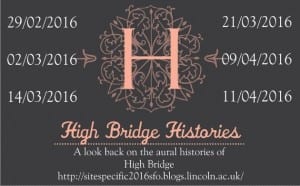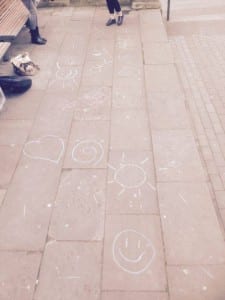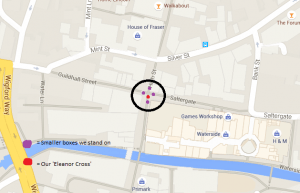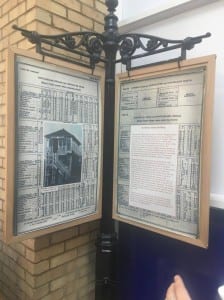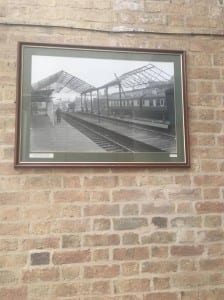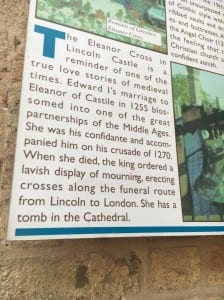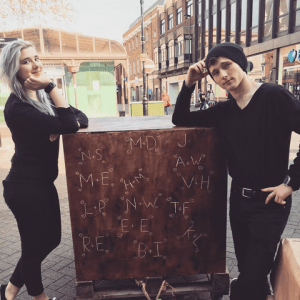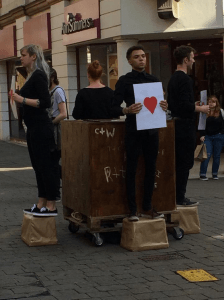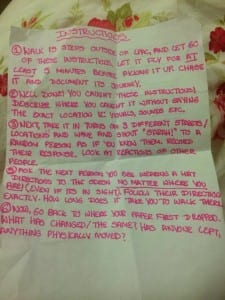Framing statement
For our site specific performance, we decided that High Bridge would be the ideal location for our site. It is a bustling area of the high street which also acts as a resting place for people to stop and socialise due to the large amount of benches in the space. Stokes Café can also be found in the site, a café which is very popular and has an outdoor seating area situated on the street in front. After researching the bridge, we found out that it ‘is the oldest bridge in the United Kingdom… dating back to 1160AD.’ (Visit Lincoln, 2015) Due to the historical background and the social potential of the space due to the café and benches, we decided that a look back on social history would be a really interesting concept for our ‘High Bridge Histories’ piece.
During our research of past site specific work, we were inspired by Georges Perec’s book An Attempt at Exhausting a Place in Paris (Perec and Lowenthal, 2010). Influenced by Perec’s documentation of everyday life, we attempted to recreate a sense of a day at High Bridge in our soundscape. We took inspiration from Marc Augé’s idea that ‘if a place can be defined as relational, historical and concerned with identity, then a space which cannot be defined as relational, or historical, or concerned with identity will be a non-place.’ (Augé, 1995) We did this by experimenting with our sound file to physically activate the space from a non-place to a place, our performance made the site a place because it gave our audience a specific memory of that space, rather than it just remaining a random area on the high street with no meaning. Cathy Turner’s concept of ‘palimpsest’ influenced the various different uses of layering in our performance and John Smith’s use of narration in his piece The Girl Chewing Gum (Smith, 1976) inspired us to use a live narrative effect as one of our layers in the performance.
On Thursday 5th May at 12pm, we performed our piece, ‘High Bridge Histories’. Each of us held a small speaker which connected to a phones to play the sound file. We were all initially out of site, until 12pm when Joe could be seen entering the space and began the 6 minute long sound file. After 1.5 minutes, I entered the space and played the sound file on my phone, afterwards, in turn, Holly and Lucy did the same. Because each of us started the file at the different times, our performance consisted of us all doing different actions with different sounds and voices layering over the top of each other. When a date played of the sound file, we would write the date on the floor in chalk. The sound file also included the sound of footsteps, during this time, we used our chalk to outline the top and bottom of our feet. When the snippets of conversations were playing, we commented on what we could see, for example ‘Man in long black coat walks past walking a dog’. We took our inspiration for this from The Girl Chewing Gum (Smith, 1976), we differed from John Smith’s work because our commentary was live in the moment, whereas, Smith put his narration over the top of video footage. For each sound effect, we had an action which made our piece more visually interesting. During the laughing sound effect, we experimented with taking the sound in different directions out of the space. When the bird noises played, we scattered bread for the birds over the dates on the floor. When the phone noises played, we handed out business cards which gave a brief explanation of what we were doing. The final sound effect was the noise of babies crying, during this, we cleaned away our footprint chalk marks with small brushes. After each of our tracks had individually stopped, we walked out of the space, everyone’s sound track had finished after 10 minutes.
Our Business Cards (Lucy Workman, 2016)
Process Analysis- The Initial Idea
Our original performance idea included a map of Lincoln on a whiteboard with clear plastic overlays which we would write local people’s opinions and stories about their city. Before performance day, we would have prepared a social media overlay, where we would have written people’s stories which they had shared with us on social media. The wheely whiteboard meant we would have been able to travel down the high street over the course of a day. We also wanted to record people’s stories to play through a speaker as the audience came and wrote on the board. This map idea was heavily influenced by Cathy Turner’s concept of palimpsest, we wanted to show layers physically as well as metaphorically with the white board.
Concerns about our concept began to emerge as we thought more deeply about the performance. The piece relied too heavily on members of the public coming to write on the board, we were worried that nobody would take part, but also that it could encourage people to write inappropriate or offensive things. We had also been concerned about the amount of elements we wished to incorporate, all the different elements over complicated the piece. The idea of transporting the whiteboard along the high street began to seem unnecessary, so we chose three different points along the high street which seemed like the most ‘sociable spaces’, one of these was High Bridge.
Process Analysis- A New Idea
After all of our concerns, we had been thinking about starting a fresh with something new. Joe suggested an idea which completely contrasted our first concept. He suggested that we sit in our site and write down people’s conversations, record other people saying them and then play the track out into the space, speaking along with it on performance day. We began collecting conversations from the space and asking members of the public if we could record them saying various lines from the script of conversations which we have written up. Inspired by Perec’s book An Attempt at Exhausting a Place in Paris (Perec and Lowenthal, 2010), we decided that if we were to use sound effects in the piece to create a better sense of the everyday. So we wrote down what else we heard in the space, this included: builders, babies crying, buskers and birds. Our idea differed from Perec’s project because, unlike us, he did not write down conversations, only what he saw, heard and smelt.
Lucy began to compile the final sound file, which came to just under 20 minutes in length. We decided that the piece should have a mixture of the conversations and the sounds which we had collected. In rehearsals, we experimented with different ways we could perform the piece as the soundtrack was playing. Our idea was to have one speaker, attached to a laptop which would be playing the sound track. We attempted to talk along with the track by reading our script along with it but this proved very difficult because of how fast the recording was. We experimented with speaking along with some of the sound file and miming other parts.
As well as experimenting with how we could deliver the piece vocally, we also decided to work on our physical delivery of the piece. We decided that we should have a movement for each sound effect. For the footsteps, we experimented with using chalk to draw around our feet. This linked well with Cathy Turner’s ideas of palimpsest because we were physically drawing a layer over the top of what is already there. For the building site noises, we were going to use a shovel to sprinkle gravel over the site. The bird noise was physicalized by us throwing bread crumbs around the space and into the water behind our site for the pigeons and swans. We bought dummies and baby bottles to suck on for the baby crying noises, and when the child noises played, we drew childish pictures on the floor in chalk.
Chalk Drawings (Joe Turner, 2016)
After a meeting with our module leader, we received feedback which could improve our piece. We were told that the piece was too long and that it was not visually interesting enough. We were also told that we were acting too much and that the piece should look as naturalistic as possibly. We were told that quite a few of our visual aspects didn’t work and just looked a bit odd, marking the footsteps worked and so did feeding the birds. We were told that the piece could be cut right down to 10 minutes, but the soundtrack would need to be re-recorded due to the voices on the track sounding far too acted. We were also told that we had a budget, so instead of just having one speaker, we could have one speaker each.
Because of the short timescale, instead of re-recording the entire sound file, we went through the recordings and got rid of the voices which sounded the most acted and kept the ones which seemed the most naturalistic. We were left with a 6 minute soundscape, by entering the space at different intervals, we were able to ensure our piece was 10 minutes long. When we were all in the space with the speakers, you could only hear what the speaker closest to you was playing, so having all four speakers playing different sections of the sound file which made waking through the space interesting because of the different layers of sound this produced.
We also altered the visual aspects of our performance. Our module leader liked the idea of us incorporating the dates where we recorded conversations into our performance in some way. We came up with the idea of including these dates in our sound file, to show the dates as a visual layer, we also wrote them on the floor in chalk. Instead of just sprinkling the bread anywhere, we decided to put the bread over the dates, therefore creating another layer which the birds would remove by eating it. Instead of drawing around the entirety of our feet, we decided to simply draw a quick mark at the top and bottom of our feet. We experimented with washing away our footprints after we had drawn them, this can be seen in the video below:
Practising Ideas (Lucy Workman, 2016)
We practiced using the narrative effect we saw in John Smith’s The Girl Chewing Gum (Smith, 1976), changing the technique to make it our own by commenting on people’s appearances live, rather than over pre-recorded which can be seen in Smith’s piece.
Performance Evaluation
An hour before the performance, we arrived at High Bridge, where to our horror, a busker was setting up ready to perform. After speaking to him, and explaining what we were doing, to our relief, he agreed to stop playing during our performance.
The warm, sunny weather we received on performance day played a large part in the success of our piece. The pleasant weather meant there were a lot more people leisurely walking about on the high street, benefitting our performance because it meant we had quite a few members of the public stopping to view our piece there were also people sitting outside Stokes Café who acted as additional audience members. During our rehearsals, we had been asked on numerous occasions what we were doing. In preparation for the possibility of this happening on performance day, we prepared a brief description of the piece: ‘A performative look back on the aural history of High Bridge’. After saying this, our plan was to give them one of the business cards and point them in the direction of our blog. Nobody asked us during our performance, however, when we had finished and went back to clean up, a couple told us they had been watching and wondered if they could have more information, so we explained and pointed them in the direction of the blog. It was nice to hear that people were interested and had stayed to watch the whole piece.
During our performance, a group of musicians could be heard playing further down the high street. After reflecting on the performance, we realised that the music added another layer to the feeling of everyday life that we aimed to convey through our piece. I felt that entering the space at different times from different areas of the high street worked well to make the activation of the space more visually interesting. The speakers worked very well during our performance, I think having one each added another interesting dimension to the performance. The visual aspects of the performance, such as the marking of footsteps on the floor and the writing of dates in chalk looked interesting and the scrubbing brushes and spray bottles worked as we had hoped they would.
During the performance, we had a few problems with our props. The chalk became an issue because they snapped so easily, meaning that members of the group had trouble writing the dates of the floor. When we had finished, Joe told us that his phone dropped out of his pocket, but I didn’t notice this during the piece, so I think he did a good job of recovering from this. Before we started performing, we were worried that we wouldn’t have any birds flocking to eat the bread off the dates an essential aspect to the performance. The adding of bread and then the bread being eaten represented a layer being physically added and then taken away. We were relieved to see the pigeons eating the bread from the dates during the performance. If I could improve the final performance, I would have made sure we had had a few more rehearsals to make us feel more confident in the final performance. We wanted the performance to have an element of spontaneity, which is why we had fewer practices but I feel that if we had rehearsed a bit more, we could have had fewer mistakes and it would have perhaps looked more professional overall.
Site specific has completely altered my understanding of what it means to perform, I always believed that performing and acting meant the same thing but site specific has taught me that they are completely different things. When you act, you make your actions stylised and exaggerated but when you perform, you can simply be doing an action as yourself.
Word count: 2498
References
Visit Lincoln (2015) High Bridge. [Online] Lincoln: Visit Lincoln. Available from http://www.visitlincoln.com/things-to-do/high-bridge [accessed 11 May 2016]
Perec, G. and Lowenthal, M. (2010) An Attempt at Exhausting a Place in Paris. Cambridge: Wakefield Press.
Augé, M. (1995) Non-Places: Introduction to an Anthropology of Supermodernity. London: Verso.
Turner, C. (Nov, 2004) Palimpsest or Potential Space? Finding a Vocabulary for Site-Specific Performance. New Theatre Quarterly, 20(4) 373-390
Ewwtubes (2012) John Smith- The Girl Chewing Gum 1967. Available from https://www.youtube.com/watch?v=57hJn-nkKSA [accessed 10 May 2016]
